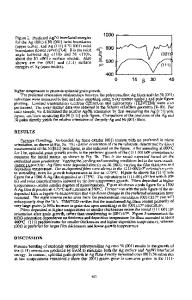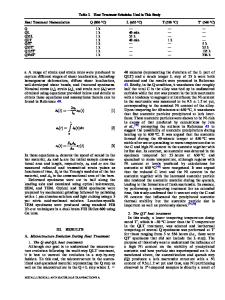Strain development during thermal treatment of steel-based MMC by high energy X-ray diffraction.
- PDF / 743,051 Bytes
- 6 Pages / 612 x 792 pts (letter) Page_size
- 43 Downloads / 271 Views
Strain development during thermal treatment of steel-based MMC by high energy X-ray diffraction. G. Geandier1, M. Dehmas1, M. Mourot1, E. Gautier1, S. Denis1, O. Martin2 and N. Karnatak2 1 Institut Jean Lamour – CNRS UMR 7198 - Université de Lorraine, Parc de Saurupt CS 50840, 54011 Nancy Cedex, France 2 Mecachrome, 27 rue de la Milletière, 37073 Tours Cedex 2, France. ABSTRACT Developments of composites materials had begun in the 1970's. They aimed in improving mechanical properties due to the presence of reinforcement particles. The addition of particles in a matrix led to different modifications: considering the nature of the phases and the microstructure, we can mention interface reactivity between matrix and particles, changes in the chemical composition of the matrix and modified kinetics of microstructure evolution in the matrix (as compared to the matrix without particles); considering the mechanical aspects, thermal stresses may be generated due to the differences in expansion coefficients between the particles and the matrix, or any changes in the matrix leading to a phase transformation. In the present work, we studied the evolution of the phases and the behavior of a steel based MMC during thermal treatments, for which a phase transformation occurred on cooling. Experiments and numerical simulation are considered. INTRODUCTION Steel-based metal matrix composites (MMC) reinforced by ceramic particles are developed to take the best part of the mechanical properties of both matrix and reinforcement. They combine a metallic matrix and reinforcement phase with final mechanical properties higher than the matrix itself [1]. Optimization of properties is correlated to the control of the MMC chemical composition, interface nature, origin of inconsistency and damage, of the matrix microstructure and by the stresses in the reinforced phase and the matrix [2,3,4]. In a previous study [5] on steel matrix composites elaborated by powder metallurgy and HIP’ed, the authors outlined the role of the particles on the microstructure formation (kinetics and nature of the phases) as well as the development of stresses during thermal treatment of the composite. Indeed, stresses are generated during cooling either due to differences of CTE and mechanical properties between the matrix and the particles [2, 3, 6, 7] or to volume change associated with phase transformations [8,9,10]. In this study, we further analyze the behavior of the steel based MMC reinforced by TiC particles by in situ X-ray diffraction during thermal treatment that led to phase transformation in the matrix. From XRD patterns, we have extracted the phase fraction and the strain evolution in each phase during cooling. A clear influence of the phase transformation is revealed considering the strain evolution of each phase. In order to analyze the strains evolution and the role of the transformation on the final mechanical state of the composite, a micromechanical model has been used to take into account each contribution to stress development: differences in CT
Data Loading...











